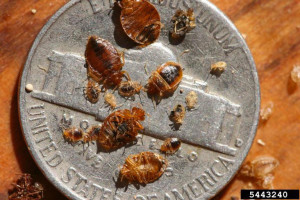Bed Bugs Don’t Arrive in Swarms
By Chris Williams on October 29, 2014.
“Itchy Business: Swarm of Bedbugs Invade Man’s House”
I saw this heading on an Internet news story recently and had to chuckle. Reporters will say anything to sensationalize a story, but then again reporters don’t understand how bed bugs work, so maybe I should give them the benefit of the doubt. Bed bugs don’t “swarm” like wasps or ants, or mosquitoes. And they definitely don’t get into homes by arriving in a big, angry horde looking for blood.
Bed bugs usually arrive quietly and cryptically, often one by one. About the only way that a bunch of bed bugs can get into a home all at once is if a heavily-infested piece of furniture, or a mattress, or some other item housing lots of bed bugs is moved in. Even then, there will be no obvious swarming. Bed bugs would rather hide than swarm.
Bed Bugs Are Adept Hitchhikers
Bed bugs infest new places mostly by hitchhiking on objects that people carry from place to place. If you set your tote bag or backpack down on a bed or floor in a bed bug-infested location, when you pick it up it may contain a bed bug (or two) that you will carry home.
Bed bugs can also infest new nearby locations by simply walking there. This is how they can move from an infested bed in one bedroom to the sofa in the living room. They can walk from one infested apartment to the apartment next door (or above, or below) by following pipe chases or cables through walls, or just walking under the door.
What We Know About Bed Bug Movement
- Bed bugs leave their hiding places and move in response to a need to feed on human blood. Each bug feeds once or twice a week.
- Most bed bug movement occurs between midnight and dawn. If bed bugs are very hungry, they will move about during the day.
- An adult bed bug can travel about 4 feet per minute. A bed bug foraging at night can travel more than 20 feet from its daytime hiding place.
- A bed bug will stay hidden near where it gets its food (the bed), unless populations are so large that it must move farther away to find hiding places or food.
- Adult bed bugs, and especially the female, are nine times more likely to migrate than the bed bug nymphs. This allows a female with eggs to infest a new area.
- Bed bugs are more active at higher temperatures and in warmer weather.
Photo: Whitney Cranshaw, Colorado State University, Bugwood.org
